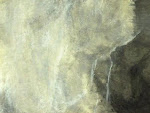Following this theory, I will explain the
painting production technique below.
3.1 "Spirit Resonance" and "Exceptionally fine work".
Why do people draw pictures? Let's think this in relation to human nature. Guo Ruoxu (郭若虚 | かく,じゃくきょ) of the Northern Song Dynasty wrote "Tuhua Jianwenzhi 図画見聞誌 (1074)" in which commentaries on "Spirit Resonance気韻生動" were found in "The Record of the Classification of Old Painters古画品録" by Xie He (謝赫 | しゃかく).
The translation into modern language is as follows.
The interpretation of "The Six Principles of Chinese Painting" has not changed from long ago. Anyone can learn "Bone Method 骨法用筆" and others.
However "Spirit resonance" is a talent given from god. Even if the picture can be drawn precisely, they cannot encapsulate "Spirit resonance". It does not change even if after years have transpired. People understand "Spirit resonance" without the use of words.
I (Guo Ruoxu) do not know why it is so. (snip) Sometimes certain paintings makes people feel a sense of nobility or elegance. If a picture has a noble character, the energy of god will also be high. If Energy of God is strong, a picture seems to be living. And that picture is called "God-like (神品)".
In another passage, he said as follows.
If a personality is high, he can draw a painting to be of "God-like" quality.
If a genius is only a decided person, people cannot draw God-like pictures.
If so, the feelings of the people who draw the picture withdraw. So at the end of the Ming dynasty, Dong Qichang (董其昌 | とうきしょう1555-1636) who developed "Southern school of Chinese painting 文人画" , said if you read many books and travel many miles, you can get "Sprit resonance" from "Huajue 画訣" (Gaketsu) in "Essay at Gazenshitsu 画禅室随筆 Volume 2". That is why the southern school of Chinese painting was popular.
Tomioka Tessai (富岡鉄斎 | とみおかてっさい, 1836-1924) was a scholar and painter of the Meiji era who researched "Japanese Study 国学", "Chinese classics 漢籍", "Yangmingism 陽明学" and "Southern school of Chinese painting". He read many books and traveled many miles then he was highly regarded as a painter.
---------------------------------
さて、「中国画の六法」に逸格を加えた理論に基づき、私は水墨画の描き方を次節以降、ご説明します。
3.1 気韻生動と逸格
人はどうして描くのか?という人間性の根源にかかわる問題も含みます。{北宋}の〔郭若虚〕(かくじゃくきょ)『図画見聞誌』 )に〔謝赫〕の『古画品録』の「気韻生動」の解説があります。現代語訳は次のとおりです。
「六法の精論(せいろん)は、古(いにしえ)より移らない。骨法用筆以下の五者は学べる。気韻は必ず主知(天分)にある。もとより(筆が)巧くても細密でも得られない。また、歳月をもっても到らない。それは、言葉を使わずに通ずる。何故そうなのかわ分からない(中略)
高雅の情は第一に画に寄するなり。人品(人格が)すでに高ければ、気韻も高からざるを得ない。気韻がすでに高ければ生動が至らざるを得ない。いわゆるこれを神にして又神にして、よく精なる(立派な)ものである。」 です。
また、同書では「気韻は学べるものではない(気韻主知論)、気韻を描ける高い人品である=気韻人格説」
として、気韻は天分による、としています。しかし、明末になると、文人画の〔董其昌〕(1555-1636)(とう, きしょう)の『画禅室随筆巻二』「畫訣」(がけつ) に「万巻の書を読み、万里の路を行けば気韻も得られる」と、文人画隆盛の基礎を築きました。
その「万巻の書を読み、万里の路を行く」を実践し、余技画家の評価のほうが高い明治の学者に〔富岡鉄斎〕(1836-1924) がおります。





0 件のコメント:
コメントを投稿